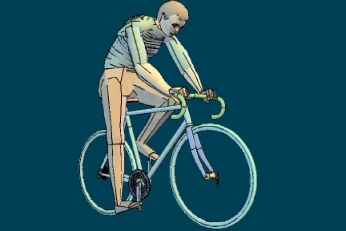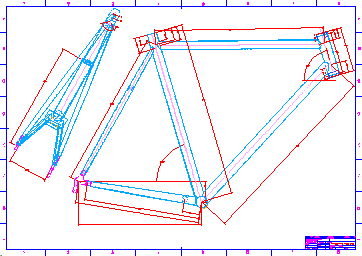Geometry
To determine the frame geometry I used a number of applications, compared the results, and also looked at the geometry of some production bikes that I have ridden. I used Accufit, Tim Patereks' program and the Competitive Cyclist fit calculator to help determine the best geometry. However, all of these tools gave different results, so I ended up using my judgment combined with my own experience to determine the final geometry. As it happens, the bike is a very good fit, but I think it would have been useful to have a proper fitting session with a professional, or to build a bike fitting jig.
| Dimension | Value |
|---|---|
| Horizontal Top Tube Length C-C | 557mm |
| Head Tube Angle | 73° |
| Seat Tube Angle | 73.5° |
| Chain Stay Length | 411mm |
| Seat Tube C-C | 540mm |
| Fork Rake | 43mm |
| Bottom Bracket Drop | 67mm |
| Head Tube Length | 148mm |
Frame Components
The Reynolds 953 parts list includes many different tube diameters, wall thicknesses and profiles. It is down to the frame designer (me in this case) to determine the best frame component for each application. I selected some of the thicker gauge and larger diameter tubes for added strength to compensate for my, perhaps less than perfect welding, and the excess pounds about my person. The seat tube that I originally ordered and received was incorrect and Reynolds replaced it for an alternative design (in fact the same tube without the swage to reduce its diameter). The original seat tube was tapered from Ø31.75mm (OD) at the bottom bracket end to Ø27.2mm (ID) at the seat end to suit a standard diameter seat post. Unfortunately on inspection, the length of tube at the seat post diameter was insufficient to adequately secure the seat post without it tending to rock inside the seat tube. This was due to a manufacturing problem at Reynolds (caused by the strength of the material). I now use a shim insert in the seat tube to allow the use of a standard seat post (I also have the option to use a larger non standard seat post).
| Part No. | Diameter mm | Wall / mm | Length mm | Butt Profile / mm | Weight / g | Qty ordered | Description |
|---|---|---|---|---|---|---|---|
| SS4020A | 28.6 | 0.55 / 0.35 / 0.55 | 625 | 120.50.320.50.85 | 190 | 1 | Top tube |
| SS4210A | 34.9 | 0.6 / 0.4 / 0.6 | 680 | 40.40.420.40.140 | 267 | 1 | Down tube |
| SS4140A | 31.75 | 0.6 / 0.3 / 0.6 | 635 | 100.75.215.75.170 | 226 | 1 | Seat tube |
| FS4520A | 17/29 oval | 0.7 / 0.5 | 410 | Taper to 15mm tip in 953 | 139 | 2 | Chainstay |
| HS4400A | 38.1 | 0.7 | 200 | Parallel | 129 | 1 | Head tube |
| GS4602A | 19.05 | 0.55 | 580 | Taper to 13mm tip | 144 | 2 | Seat stays |
The frame fittings were a bit of a no brain-er, because there wasn't a lot of choice for these bits. I could have purchased some non-Reynolds 953 components separately, but didn't much see the point of that. One exception to this was the STI braze-on's (gear cable adjusters on the downtube). These parts as manufactured by Reynolds were a little disappointing due to the complete absence of any base to spread the load on the downtube. Alternative stainless steel adjusters were purchased separately from Ceeway.
Other Components
I chose Shimano's 105 groupset, which is Shimano's mid range road groupset. In 2006 Shimano introduced a 10 speed version of the 105 groupset which means as parts wear out I will be able to mix and match groupset components with Ultegra or Dura Ace (top of the range) components. By selecting the triple version of the groupset, I will have the possibility of changing the chainset from a triple to a compact (not so easy if you have a double).
| Name | Make | Model | Details |
|---|---|---|---|
| Chainset | Shimano 105 10 speed triple groupset |
FC-5603 | 172.5mm 30/39/50 |
| Chain | CN-5600 | 10 Speed | |
| Rear derailleur | RD-5600 GS | Long cage | |
| Front derailleur | FD-5603 | Triple, band type | |
| Brakes | BR-5600 | ||
| Cassette | CS-5600 | 12-25T | |
| Levers | ST-5600 | ||
| Computer | Shimano | SC-6502 | Flightdeck |
| Pedals | Shimano | PD-A520 | SPD Compatible |
| Wheels | Mavic | Aksium | |
| Forks | Columbus | Carve | 43mm rake |
| Tyres | Vitoria | Open Corsa Evo-KS | 700 x 23mm |
| Saddle | Fizik | Pave Ti | |
| Headset | Cane Creek | S-3 | |
| Bars | ITM | Super 300 | 440mm |
| Stem | ITM | Forged lite | 110mm |



 bike in 3D: low res
bike in 3D: low res frame drawing (pdf)
frame drawing (pdf)